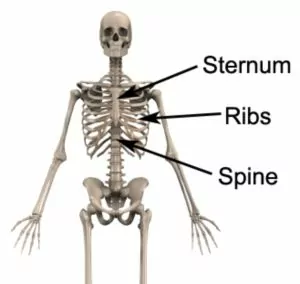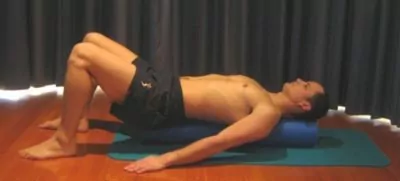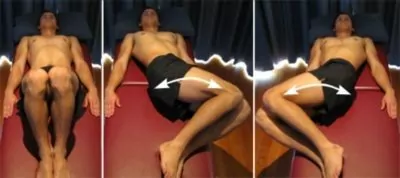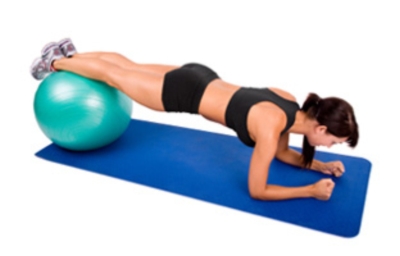Intercostal Strain
Updated:
(Also known as an Intercostal Muscle Strain, Intercostal Muscle Tear, Torn Intercostal)
What is an intercostal strain?
An intercostal strain is a condition that is occasionally seen in sports such as cricket (i.e. in fast bowlers) and is characterised by a tear in one of the muscles located between the ribs (known as the “intercostals”).
The chest comprises of 12 rib bones on each side of the body. Each rib attaches to the spine at the back of the body and then travels around to the front of the chest (figure 1). The top 7 ribs attach to the sternum, the 8th to 10 ribs attach to the ribs above via cartilage and the 11th and 12th ribs are known as ‘floating’ ribs as they are unattached at the front of the chest.

Numerous muscles of the abdomen, shoulder girdle and back attach to one or more ribs. The intercostal muscles are a group of muscles that run between the ribs, attaching from the rib above to the rib below and are primarily responsible for elevating the ribs (allowing for inspiration) and forming the chest wall.
During contraction or stretch of the intercostals tension is placed through the muscles. When this tension is excessive due to too much repetition or high force, a tear in one or more of the intercostal muscles may occur. This condition is known as an intercostal strain.
Cause of an intercostal strain
An intercostal strain can occur either suddenly (e.g. from a forceful bowl, particularly if not warmed up properly) or gradually over time from excessive or repetitive activity (e.g. over-training). They most commonly occur due to a sudden contraction of the intercostal muscles when they are in a position of stretch (such as during the fast bowling action) or during other activities involving excessive side bending or twisting forces.
In athletes, intercostal strains are most commonly seen in cricket (fast bowlers), javelin throwers, rowers and ice hockey players. Occasionally they may occur traumatically due to a direct impact to the ribs, forcing the ribs apart such as a collision in contact sports or due to a motor vehicle accident.
Signs and symptoms of an intercostal strain
In cricket fast bowlers, intercostal strains tend to occur on the non-bowling arm side of the body. Patients typically experience a sudden, sharp pain or pulling sensation in the side of the chest (often in the region of the lower ribs) during the provocative activity. Pain typically occurs suddenly (e.g. during a forceful bowl), but can also occur gradually over time (e.g. over the course of a match or training session).
In minor cases, the patient may be able to continue the activity only to have an increase in symptoms upon cooling down. In more severe cases the patient may be unable to continue the activity and will often have to cease sports participation. Patients with an intercostal strain typically experience pain that increases with activities that place strain on the intercostal muscles. These activities may include: bowling, throwing, heavy lifting, rowing, side sit ups, twisting, turning or side bending. It is also common for patients to experience pain or stiffness after these activities with rest, especially upon waking in the morning (or at night).
Patients with this condition may also experience swelling, muscle spasm, weakness and bruising in the side of the chest. Symptoms typically increase on firmly touching the affected region of the muscle or ribs or when performing a side stretch. In more severe cases, deep breathing, laughing, coughing or sneezing may also provoke symptoms.
Diagnosis of an intercostal strain
A thorough subjective and objective examination from a physiotherapist is usually sufficient to diagnose an intercostal strain. Further investigations, such as an X-ray, MRI, CT Scan or ultrasound, are sometimes required to confirm diagnosis, rule out other conditions, determine the severity of injury and monitor healing.
It’s important to note that on close examination, many patients who present with symptoms of an intercostal strain are actually suffering from referred pain from the thoracic spine. This may be from common conditions such as a thoracic disc bulge, costovertebral joint sprain or spinal degeneration.
Prognosis of an intercostal strain
With appropriate physiotherapy management, most patients with an intercostal strain can make a full recovery (i.e. return to sport or normal activities) in a period of 4-6 weeks. In more severe cases, recovery may take longer.
Treatment for an intercostal strain

Members Only ContentBecome a PhysioAdvisor Member to gain full access to this exclusive content. For more details see Become a Member. Already a member? Login Now
Contributing factors to the development of an intercostal strain
There are several factors which may contribute to the development of an intercostal strain. These need to be assessed and, where possible, corrected with direction from the treating physiotherapist. Some of these factors include:
- inappropriate warm up
- inappropriate or excessive training
- inadequate recovery periods from training or activity
- poor sporting technique (e.g. bowling technique, throwing technique)
- bowling speed (faster bowlers are more likely to develop an intercostal strain)
- poor core stability
- muscle weakness
- poor flexibility
- joint stiffness (particularly the upper back or lower back)
- poor posture
- fatigue
- a lack of fitness or conditioning
- inadequate rehabilitation from a previous abdominal or lower back injury
Physiotherapy for an intercostal strain
Physiotherapy treatment for patients with an intercostal strain is vital to hasten healing, prevent injury recurrence and ensure an optimal outcome. Treatment may comprise:
- soft tissue massage
- joint mobilization
- joint manipulation
- stretches
- electrotherapy (e.g. ultrasound)
- ice or heat treatment
- anti-inflammatory advice
- dry needling
- activity modification advice
- technique correction
- protective taping or postural taping
- exercises to improve strength, flexibility, core stability and posture
- hydrotherapy
- education
- a gradual return to activity plan
Other intervention for an intercostal strain
Despite appropriate physiotherapy management, some patients with this condition do not improve and may require other intervention to ensure an optimal outcome. The treating physiotherapist or doctor can advise on the best course of management when this is the case. This may include further investigations such as an ultrasound, MRI, X-ray, CT scan or bone scan, extended periods of rest, pharmaceutical intervention, or referral to appropriate medical authorities who can advise on any intervention that may be appropriate to improve the intercostal strain.
Exercises for an intercostal strain
The following exercises are commonly prescribed to patients with an intercostal strain. You should discuss the suitability of these exercises with your physiotherapist prior to beginning them. Generally, they should be performed 3 times daily once the physiotherapist has indicated it is safe to do so and only provided they do not cause or increase symptoms.
Your physiotherapist can advise when it is appropriate to begin the initial exercises and eventually progress to the intermediate and advanced exercises. As a general rule, addition of exercises or progression to more advanced exercises should take place provided there is no increase in symptoms.
Initial Exercises
Deep Breathing
Begin sitting or standing tall with your back and neck straight (figure 2). Breathe in as deeply as possible without increasing symptoms and then relax. Focus on breathing with your lower lungs (instead of elevating your shoulders) and allow your stomach to gently expand. Repeat 5 times.

Foam Roller Stretch
Place a foam roller under your upper back as demonstrated (figure 3). Breathe normally keeping your back and neck relaxed. Hold this position for 15 – 90 seconds provided it is comfortable and does not cause pain. This exercise can be progressed by taking your arms overhead.

Rotation in Lying
Begin this exercise lying on your back as demonstrated (figure 4). Slowly take your knees from side to side as far as you can go without pain and provided you feel either nothing, or, no more than a mild to moderate stretch. Repeat 10 times to each side provided the exercise is pain free.

More Initial Exercises

Members Only ContentBecome a PhysioAdvisor Member to gain full access to this exclusive content. For more details see Become a Member. Already a member? Login Now
Intermediate Exercises

Members Only ContentBecome a PhysioAdvisor Member to gain full access to this exclusive content. For more details see Become a Member. Already a member? Login Now
Advanced Exercises

Members Only ContentBecome a PhysioAdvisor Member to gain full access to this exclusive content. For more details see Become a Member. Already a member? Login Now
Rehabilitation Protocol for an intercostal strain

Members Only ContentBecome a PhysioAdvisor Member to gain full access to this exclusive content. For more details see Become a Member. Already a member? Login Now
 Physiotherapy products for an intercostal strain
Physiotherapy products for an intercostal strain
Some of the most commonly recommended products by physiotherapists to hasten healing and speed recovery in patients with this condition include:
To purchase physiotherapy products for a strained intercostal, click on one of the above links or visit the PhysioAdvisor Shop.
 Find a Physio for an intercostal strain
Find a Physio for an intercostal strain
Find a physiotherapist in your local area who can treat this condition.
 More Exercises
More Exercises
- View Upper Back Stretches.
- View Upper Back Strengthening Exercises.
- View more Shoulder Stretches.
- View more Shoulder Strengthening Exercises.
- View more Scapular Stability Exercises.
- View more Core Exercises
- View more Beginner Pilates Exercises.
 More Information
More Information
- View detailed information on when to use Ice or Heat.
- View detailed information on initial injury management and the R.I.C.E Regime.
- Read about Posture and Ergonomic Computer Setup.
- Read about Posture Taping.
- View detailed information on Warming Up and Cooling Down.
- View detailed information on Returning to Sport.
- View detailed information on Return to Running
- View our Upper Back & Chest Diagnosis Guide.
+ 6 References
PhysioAdvisor primarily relies on randomised controlled trials and credible scientific sources to guide our content creation. Read about our sourcing guidelines and how we create trusted content via our editorial policy.
- Brukner et al (2012). Brukner & Khan’s clinical sports medicine (4th ed.), 456. Australia: McGraw Hill Education.
- Baoge I, Van Den Steen E, et al: Treatment of skeletal muscle: A review: ISRN Orthopaedics, Volume 2012, Article ID 689012. http://dx.doi.org/10.5402/2012/689012.
- Noonan TJ, Garrett WE Jr.: Muscle strain injury: diagnosis and treatment: J Am Acad Orthop Surg. 1999 Jul-Aug;7(4):262-9.
- How to identify and treat an Intercostal Muscle Strain (2017) – www.healthline.com/health/intercostal-muscle-strain
- What is an Intercostal Strain (2018) – www.medicalnewstoday.com/articles/320925.php
- Treating Intercostal Muscle Strain (2017) – www.spine-health.com/conditions/upper-back-pain/treating-intercostal-muscle-strain
Become a PhysioAdvisor Member
-
 Individual Membership (12 Months)$59.95 for 1 year
Individual Membership (12 Months)$59.95 for 1 year -
 Individual Membership (3 Months)$39.95 for 3 months
Individual Membership (3 Months)$39.95 for 3 months -
 Individual Membership (Yearly)$49.95 / year
Individual Membership (Yearly)$49.95 / year -
 Individual Membership (Monthly)$15.95 / month
Individual Membership (Monthly)$15.95 / month

Link to this Page
If you would like to link to this article on your website, simply copy the code below and add it to your page:
<a href="https://physioadvisor.com.au/injuries/upper-back-chest/intercostal-strain”>Intercostal Strain – PhysioAdvisor.com</a><br/>PhysioAdvisor offers detailed physiotherapy information on an Intercostal Strain including: causes, symptoms, diagnosis, treatment, exercises, rehabilitation, physiotherapy products and more.
Return to the top of Intercostal Strain.






